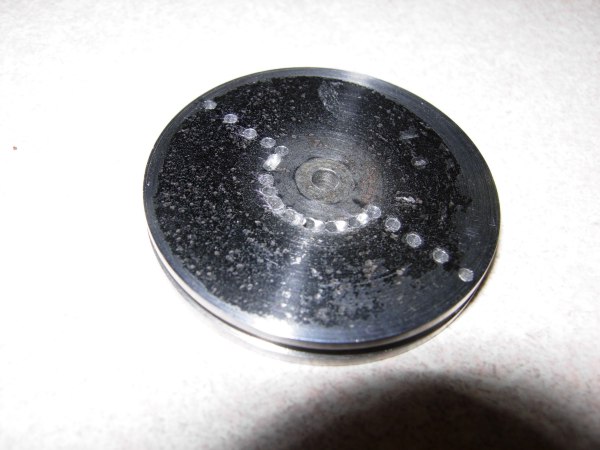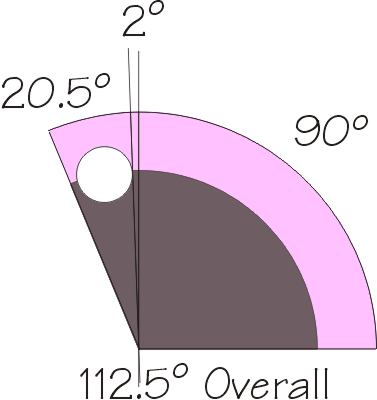Clinic
You CAN do it...
Fabricating a TPS Driver |

|
| Written by Randy Fox (randysgym) | |
| Thursday, 27 August 2009 | |
|
Page 5 of 10
Finishing the Pulley for Dual CablesOnce the basic pulley was made, I split it in half so as to make two semi-circular pulleys. To do this, I first sanded, filed, machined, and/or ground one side of the pulley to be as flat, and parallel to the groove, as possible. Tip: It would probably have been easier to have done this step before cutting the groove. Then, I drilled a series of small, closely spaced holes, along a diameter-line, but circumscribing the center area of the pulley, to meet the diameter-line holes. See photo below. Tip: I think it would have been much easier to have used a plasma cutter or a steel cutting coping saw.
Next, a cutoff wheel on a Dremel was used to cut through both sides along the diameter-line, between the holes. Then a small diameter, straight-shaft, diamond cutter bit was used on the Dremel to cut through the semi-circle holes and complete the pulley bisection. It took a long time. See photo below. Tip: Again, I think it would have been much easier to have used a plasma cutter or a steel cutting coping saw.
Remember, only 1/4 turn (90 degrees) is required, so considerably more pulley trimming can be done. The next step was to sandwich the two, pre-flattened sides together, using an offset. To do this, I laid each pulley onto a protractor (degree wheel) and used a permanent marker to mark 45 and 135 degrees from one edge. Then it was easy to find the 90 degree offset. The pulleys were glued and clamped together at this offset. JB Weld was the glue used. See photo below.
After this, holes for the throttle-cable end-barrels needed to be drilled. My plan was to use two cable segments:
The holes were drilled at 112.5° for each pulley:
See diagram below.
The pulleys overlap each other by 90°, which leaves 22.5° of non-overlap area at each end. To drill the cable-end holes at the correct location, I first made a protractor template. See template below.
Then I transferred marks from the template to each pulley, at 90° and 92°, as given by the template. Tip: I used a permanent marker, but a scriber might offer better precision. My next step was to find the center point for the cable-end hole. I did this by measuring the diameter of my cable end-barrel (the tiny cylinder at the end of the throttle cable) -- mine was 0.24" -- dividing that number in half, and then marking a dot on the pulley, 0.12" from my 92° mark -- in the direction away from 90°. I then drew a line through this mark and the pulley's pivot point. I called this my cable-end line. Next, I placed an aluminum straight-edge (but a credit card would work as well) down into the pulley groove. I positioned the straight-edge so that it touched the bottom of the groove at my cable-end line. Then I precisely marked the points where the straight-edge met the outside edge (along the pulley's largest diameter). Note: A line between these points will be perpendicular to my cable-end line. See photo below. The photo does not show the 92° mark.
Then I repositioned the straight-edge to the outside, and aligned it across my two edge-marks. Then I just marked a line segment to intersect my cable-end line. I thus had a 'cross-hairs' to mark just about where the center of the cable-end hole would be. Next, I adjusted my 'cross-hairs' point by one half the thickness of the throttle cable (0.008" in my case) up -- toward the perimeter of the pulley -- and center-punched it as the center-point of the cable-end hole. I chucked a 1/4" drill bit into my drill press, and drilled through, for the cable end-barrel. Tip: You could use a hand-held drill, as long as you're careful to get a clean, straight hole. Repeat those steps for the opposing pulley. See result, below.
Then I just trimmed the ends of each pulley segment. See photo below.
Then it was just a matter of cutting a slot through ½ of the pulley into the cable end-barrel hole so as to allow the cable end-barrel to be inserted. Tip: I cut my cable-insert slot into the cable-end-barrel hole from the outside edge of the pulley. See photo below. This makes it very difficult to install the cables onto the pulleys. I wish I would have cut the cable-insert slot from the hole to the perimeter of the pulley. Although that would leave the pulley slightly weaker, there is very little stress on it anyway. And finally, you could drill some holes and do some milling to lighten the overall weight, and clean it up a bit. See photo below.
Assembling the Pulley PartsThe axle and pulley get connected via a simple set screw in a hole drilled through the edge of the pulley's center. This allows me to adjust the pulleys to be in exact sync (harmony) with the TPS. To make this hole, I Drilled a 0.09" hole into the edge of the pulley's axle hole. This hole was then tapped for a 4-40 set-screw. See photo below.
|
The Road Star Clinic is a collaborative community of riders who archive and publish user contributed technical data about Yamaha Road Star motorcycles.









